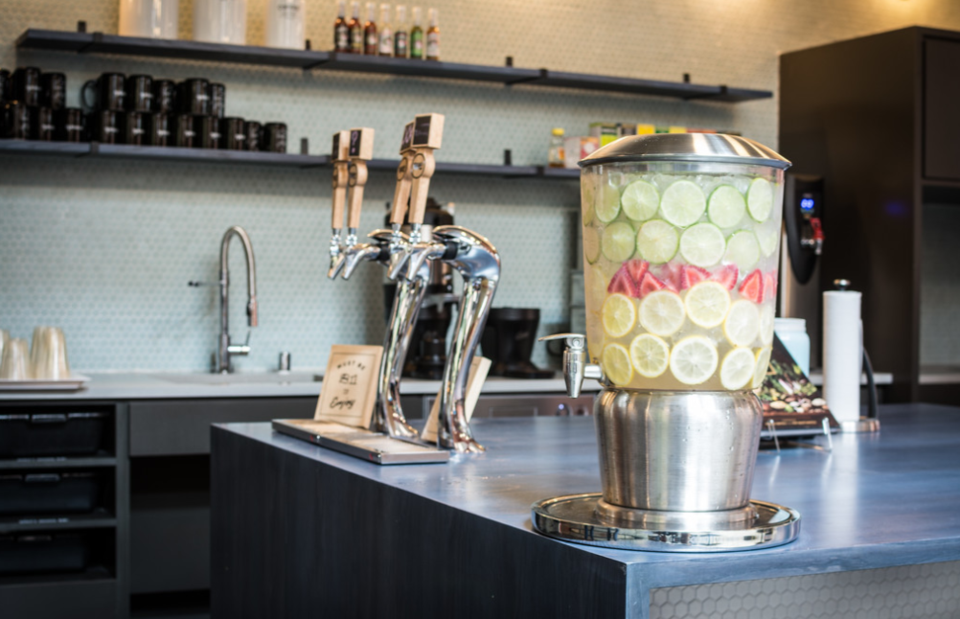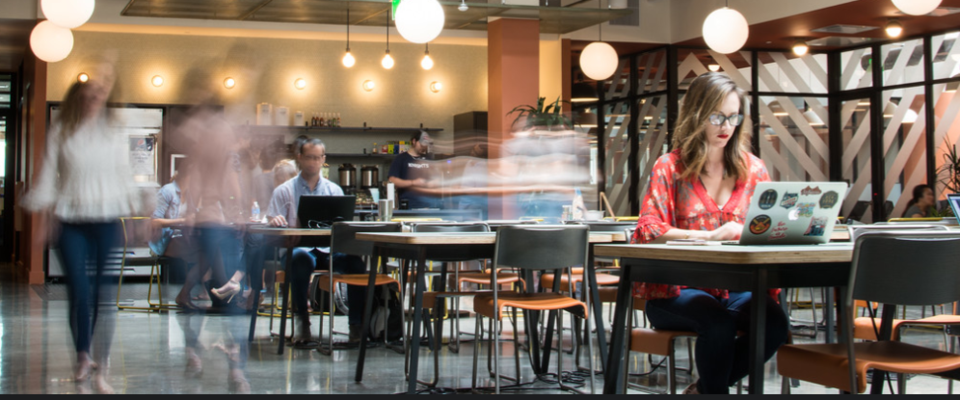On the first floor of 7600 Windrose Avenue, the morning is as undisturbed as a glassy lake. On the second, faint music begins to drift down from above. And then on the third, Justin Timberlake’s “Can’t Stop the Feelin’” is party-loud. It’s 9 a.m. on a Monday at WeWork Legacy West, one of the newest WeWork hubs located across the globe. Inside a few glassed-walled offices, members are already deep in meetings. The WeWork staff and their laptops man the community bar at the entrance, ready to facilitate a hard day’s work. Why are you gawking in the doorway when there’s stuff to do?
The Legacy West office has no cubicles and no fluorescent lights. The floor plan streams from an open area with a coffee shop atmosphere to private, soundproof phone booths for deep concentration. Complimentary coffee is always hot and the free craft beer is always on tap. The members at Legacy West hook into a global network of WeWorkers, over 100,000 businesses that range from tiny startups that started-up yesterday to monoliths like PepsiCo, Microsoft and Bank of America. I nabbed a desk at WeWork for a week to get to the bottom of its allure and to figure out why it’s working.
Read more: Everything you can eat at Legacy West
WeWork is not just about complimentary coffee, moveable space and other perks. Back in 2008 its founders, Miguel McKelvey and Adam Neumann, created an environmentally responsible office space called Green Desk. They tooled around with it for a couple of years before deciding they could go much further and in 2011 opened WeWork’s first location in Soho. Now there are 203 buildings in 50 cities. Hong Kong has two offices; New York has 40. WeWork members in Plano can conference with members in Israel, the UK, the Netherlands, South Korea, Argentina and, soon, Japan.
Adam Wacenske, the General Manager of WeWork’s Southern Region, first walked into WeWork in New York and was so enamored he just asked for a job. “I was like, ‘Start me anywhere,’” he recalls.
Adam describes “a fundamental shift” in the way people want to work. “They’re looking for meaning over money, and WeWork has tapped into this,” he explains. “We’ve created global communities and provided resources to help accelerate this shift.” WeWork has coined their members, “The We Generation”.
WeWork’s space is industrial, yet homey. Natural light streams in through skylights and potted plants, the stalwart breed only ever found in offices, are everywhere. I’m particularly fond of the weathered antique books on the conference room coffee tables. Some WeWork locations even have meditation rooms, pool tables, bocce ball courts and ping pong tables, where business frequently comes down to the final score.
Legacy West’s staff members, led by the indomitable Aimee Bentson, are ready to answer questions, give tours and—all in all—function like diplomats, businesspeople and concierges all at once. They are the architects of peace in the workplace—and the DJs who control the music. They’re there to take care of the small stuff so members can get to work.
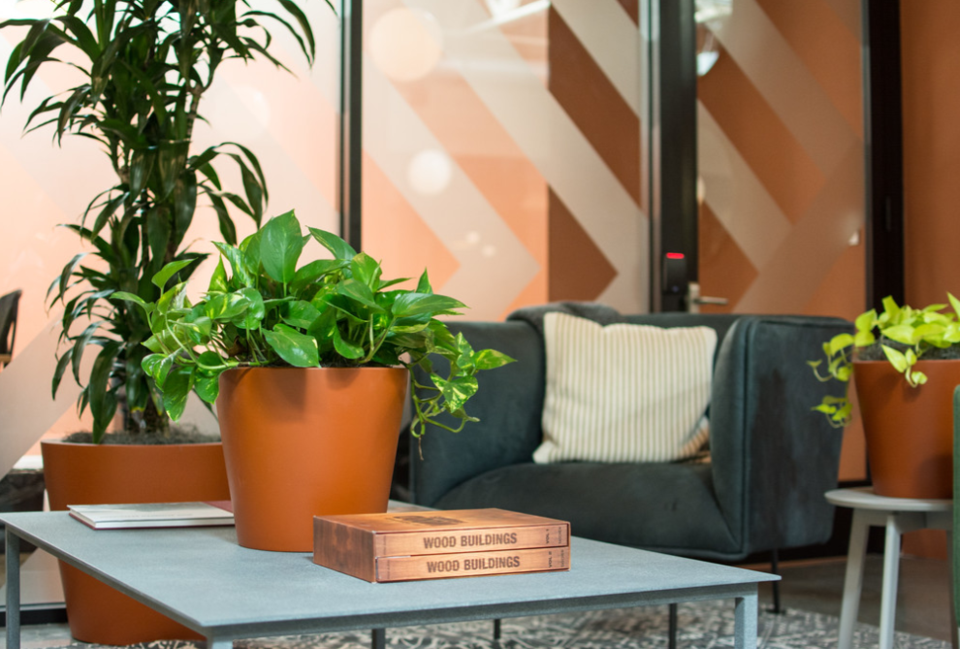
Every Monday, either breakfast or lunch is brought in. Torchy’s Tacos make frequent appearances—the Crossroads taco is life-changing—and one member takes advantage of lunch to set up her product, a local salsa brand. She perches on a chair nearby, offering samples and explaining each one. Demos like this are commonplace: on another occasion, members got to enjoy complimentary champagne and Steel City Pops. PepsiCo is a member at Legacy West, so there are a ton of free Pepsi products in the kitchen.
“The more we grow, the more resources all our members have,” Adam says. “The more there is, the better.”
Looking around, WeWork isn’t just full of millennials on iPads. Business people from all walks of life, all ages, all hair colors and all success levels mingle around the fruit-infused water. They share the same amenities, partnership opportunities and parking spaces. In the scramble for fresh coffee, they brush shoulders as they reach for the almond milk. The businesses they run aren’t just tech companies. A salon has even rented a private office space with a doctor’s chair. You’ll see beauty technicians learning to apply false eyelashes just down the hall from an Uber licensing office.
Every member has a keycard and is on the WeWork app. Though the location’s staff is only there during the normal workday, members have 24/7 access. Members can easily book glass-walled conference rooms. Some are modern and wide for big meetings while others, made for two at the most, are styled after living rooms with blankets, books and sofas. Though it is designed for collaborative work, a secluded, quiet hideaway is never out of reach. One conference room with warm red walls and a fluffy couch quickly becomes my favorite haunt.
There are “hot desks,” casual workplaces in the open area that are shared with other members. These are a few rows of heavily outletted tables in the center of the room within spitting distance of free snacks—Reese’s Pieces, M&M’s, Jelly Beans—to keep your sugar rushing. People move around here; different faces show up in different places. It’s perfect for startups without much of a budget.
WeWork also has “dedicated desks”, assigned workspaces in a similar open area. These desks come with lockable filing cabinets for belongings.
Members can also book full enclosed private offices with lockable spaces, and customize them to meet their needs.
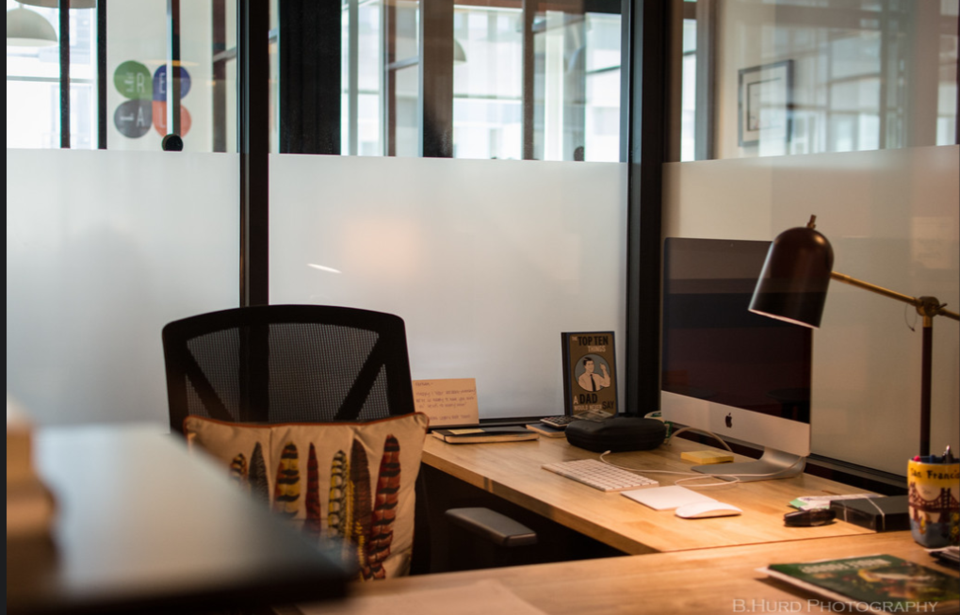
Read more: A look at Legacy Hall
Joining WeWork doesn’t just entitle you to the amenities at one location. Once you become a WeWork member, you can book a workspace at any location around the world for just $50 a day. Companies that join become global overnight, invited into a massive community based on collaboration. In their local WeWork office, they’ll literally bump into members from other businesses, but through the networking app, they’ll discover potential partnerships across the world.
“Community is the future,” Adam continues. “In the workplace, at home—it’s what’s going to drive the future. People come to us because they want these experiences and don’t necessarily care about nine-to-five and climbing the corporate ladder.”
One member is Kim Zoller, founder of ID360. A sharp-eyed former psychologist, she specializes in recognizing potential and helping others achieve it professionally. She’s also one of WeWork’s biggest cheerleaders.
“I started at WeWork the day it opened in Dallas,” she says. “The energy is just awesome. You could find a cheaper office but it isn’t the same.”
A number of months ago, her company was ready for a rebrand as well as an upcoming summit on women in the workplace. She put a note out about it on the WeWork website, asking for advice about the transition.
The feedback was overwhelming—in a good way. “We got an amazing response from companies from all over the world and ended up hiring a company in Chicago run by three sisters called Amelia Street Studios. They’re doing all the branding for the summit and the website design. It literally blew me away.” This isn’t surprising; 70 percent of WeWork’s members are currently collaborating with other members.
While the environment at WeWork isn’t for everyone, she describes a like-mindedness that draws WeWorkers together. “The people who come here have a quality about them. You walk down the hallway, and you greet people. It’s nice. People that work here are incredible.”
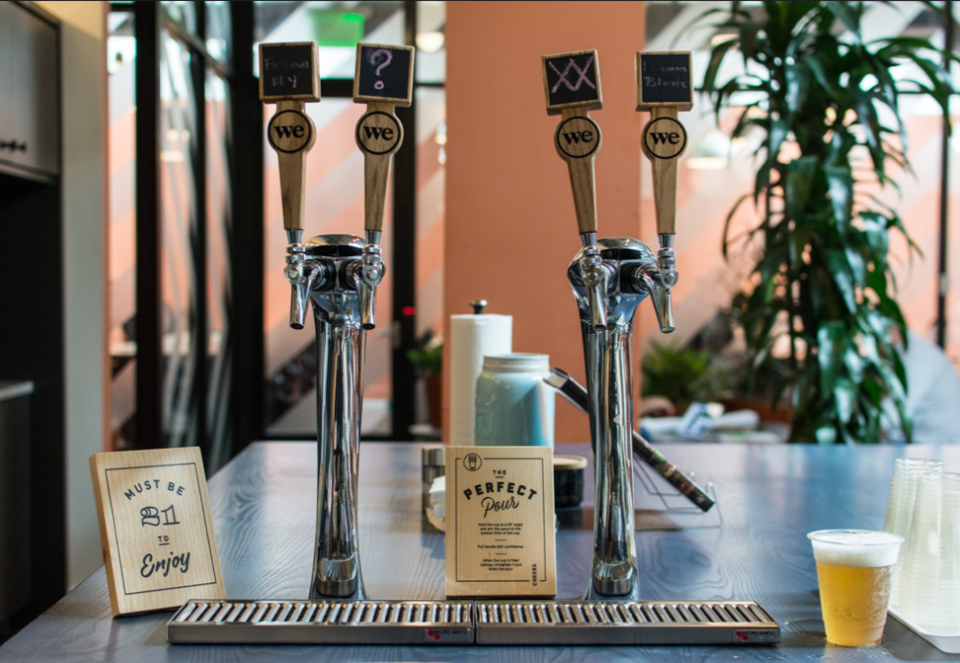
WeWork has observed a shift in concepts of wellness in the workplace and believe their member retention and happiness is down to the environment. Some offices have meditation rooms; Legacy West has a room for new mothers to pump or nurse in private. As Adam puts it: “If you’re only happy in certain aspects in your life you won’t be fulfilled.”
Inspiration is intangible, but WeWork fosters it efficiently. Their tools include: natural light, comfort, collaborative work spaces, fun surprises, good food, and most importantly, good company. Breaks are easy and perfect strangers are quick to ask how your day is going. They don’t just exist in private little bubbles but actively seek out connection.
“Our members are here because of one thing: they want to be a part of something bigger than themselves, work next to different people, exchange ideas,” Adam explains. “There are a lot of other coworking spaces, a lot of people in general that are interested in this [type of place]. But what we offer, the global network, is unique.”
WeWork is a part of a new generation of workplaces, both a symptom and a cause of the office feng shui that has been building in the larger business world.
The nature of work is currently in flux. Ever since the hammocks, foosball tables and indoor slides at Google’s offices launched widespread envy, businesses large and small have been trying to decipher how the next generation will want to work—are desks bad? Are open floor plans good? Do we even need offices, or should we all just hunker down on our couches at home with our WiFi and ramen noodles?
While there isn’t necessarily one right way to maximize productivity, the flexibility WeWork offers would seem to be key—because different people will find that different office situations suit their different needs.
The result of the ongoing debate has been exciting. Alternative work spaces, artful work spaces and sometimes alien work spaces have led to the tear-down of cubicles, the influx of art and the chance to make our working years better, more productive and more rewarding overall. There are new technologies and new ways to utilize them.When businesses have them at their fingertips, the potential is staggering.
Ready to get to work?
